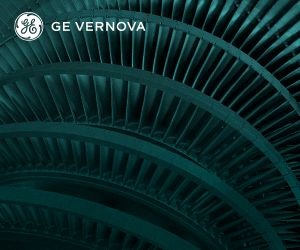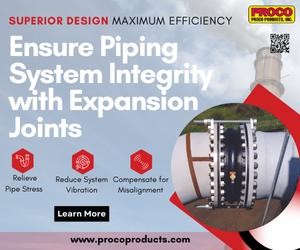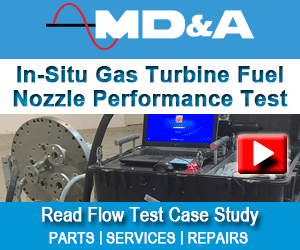Reliable electric supply in the Kingdom of Saudi Arabia depends to a large degree on the proper operation of gas turbines, which dominate the country’s generation infrastructure. At the end of 2018, Saudi Electric Co (SEC), the leading producer of electricity with a nominal 70% market share, had 53,500 MW of capacity installed at its 40 powerplants. Simple-cycle gas turbines comprised about one-third of that total, combined cycles a quarter, and oil- and gas-fired steam turbines most of the remainder.
Worth noting is that Saudi Arabia is the world’s largest producer of desalinated water, relying on 17 facilities to provide that product. Several desal facilities have been sited together with power stations.
Many types of gas turbines are installed in Saudi Arabia for electricity production and mechanical-drive applications. They include the GT11, 501D5, 501D5A, V84.2, M501F, Frame 5, and 6B; most are scattered among the various IPPs and industrial self-generators. By contrast, SEC relies heavily on GE Frame 7s and has more than 150 EAs and FAs in its fleet.
SEC plant personnel often participate in 7F Users Group meetings in the US, but it’s impractical financially for more than a few of the company’s many engineers to attend. A solution was to hold a Combined Cycle Conference (Apr 3, 2019) and a Power Generation Technical Workshop (Dec 11, 2019) in Saudi Arabia.
The first meeting, sponsored by SEC, was hosted by the Ali A Tamimi Co and coordinated by Keck Group International LLC (Fig 1). Tamimi is a respected provider of engineering and onsite O&M services—including turnkey upgrade projects—to SEC and others in the power, petrochemical, and oil and gas industries. KGI, headed by two former GE executives—Richard Keck and Bob Johnston—provides consulting services in support of combined-cycle operations and performance improvements.
![]()
The second conference was sponsored by Saudi Aramco, a/k/a Saudi Arabian Oil Co, at its facilities in Dhahran (Fig 2). Saudi Aramco, which owns 7% of SEC, is both the utility’s main fuel supplier and an important customer.
![]()
Combined-cycle conference
Adel Al Shuraim, CEO, Tamimi Energy, opened the Combined Cycle Conference. His welcome was followed by that of Khalid Al Tuaimi, EVP, SEC Operations. The morning’s technical presentations followed, beginning with recommendations for improving combined-cycle performance by CoreTech Industrial Corp’s Joel Holt, engineering manager and Bruce Martindale, consulting engineer.
Holt (Fig 3) and Martindale did double duty, following up their opening presentation with a primer on how to reduce plant startup time. Johnston was next with a review of uprates for non-capital parts—with no changes to existing gas-turbine capital parts.
![]()
HRSG improvements were addressed by CMI Energy’s technical manager, Raphael Stevens and VP Habib Grini.
Presentations on steam-turbine upgrades and training programs for gas-turbine, steam-turbine, and generators, were developed by MD&A’s Eamonn Rogers and Dave Hagenbuch.
Exhaust-system upgrades and repairs, by Innova Braden Europe’s Ed Chan and Moustafa Al-Shami, closed out the morning program.
The afternoon was reserved for Q&A and open discussion.
The presentations focused on specific issues that each vendor had addressed at combined-cycle plants and showed how that experience could benefit generating facilities in Saudi Arabia. The vendors participating in the conference had agreed to work collaboratively to provide owner/operators of the kingdom’s 15 operating combined cycles complete solutions. Representatives from all those powerplants were among the 100 or so attendees.
Saudi Arabia’s combined-cycle infrastructure includes the following, based on CCJ’s research:
-
- Ten 7EA-powered 4 × 1 plants designed for crude oil only. Gas turbines, rated 56 MW each, installed from 2010 to 2012; 130-MW GE steam turbine/generators added to each block between 2014 and 2016 along along with unfired NEM HRSGs.
- A 7001FA-powered 3 × 1 designed for gas only installed in 2012, equipped with Hyundai HRSGs and a GE D11 steamer.
- A 7000FA-powered 4 × 1 designed for gas only installed in 2013, equipped with Hyundai HRSGs and a GE D-11 steamer.
- Two 7F.05-powered 4 × 1 facilities designed for gas with oil backup. Gas turbines, rated 172 MW each, installed in 2014-2015; Alstom HRSGs and 341-MW steam turbine/generators added to each block in 2017.
- Four 7F.05-powered 3 × 1 facilities designed for gas only are scheduled for 2021 operation. Gas turbines, rated 215 MW each, will be integrated with Alstom HRSGs and 342-MW Alstom steam turbine/generators.
Featured Solutions Provider
Holt and Martindale breezed through a review of the principal systems and components in a combined-cycle plant, explaining the functions of each in relatively few words. Then they summarized plant startup (hot, warm, cold) and shutdown procedures, identifying issues sometimes experienced with each step and how to avoid them.
Technical warmup complete, the speakers were ready to tackle one of the meeting’s primary objectives: Encourage attendees to pursue procedural and equipment changes to enable faster starts of their combined cycles without compromising reliability and service life.
The significant penetration of renewables into the power generation market has caused many combined cycles to switch from baseload operation to cycling duty—including the ability to start quickly when non-fuel resources suddenly disappear.
The speakers noted that combined cycles installed in the last five years or so typically were designed and equipped for the new demanding service. But some older plants are not able to accomplish warm starts in less than four hours, which makes profitable dispatch difficult, if not impossible, in today’s competitive power markets. However, new procedures, software, and some equipment upgrades, the group was told, could drive down plant warm restart times to 90 minutes with a generally acceptable investment.
Performance improvement was another topic of major interest given older combined cycles have suffered efficiency reductions over the years. To fully assess areas that should be addressed to improve thermal performance, the speakers recommended doing a current heat balance and comparing it to the original. The main areas requiring improvement will stand out, it was said.
Focused uprates within the capability of existing equipment are a proven path to performance improvement. Keep in mind that most older gas turbines receive upgraded parts when they purchase replacements or spares because OEMs are continually improving the capability of their offerings.
But manufacturers rarely assess the overall capability of the GT when only selling parts. Owner/operators, sometimes assisted by an independent consultant, frequently find a thorough review can guide the selection of parts capable of increasing GT output by as much as 3%, possibly more. This, plus the accompanying increase in exhaust energy boosts overall combined-cycle power and efficiency.
A comprehensive audit of the physical plant, and of the procedures that guide operations, often point to affordable improvements with big returns. The HRSG can be an efficiency hog when wear and tear allows flue-gas bypass of heat-transfer surfaces and catalyst by way of failed baffles and seals, and when gas- and/or water-side deposits retard heat transfer. Steam-turbine upgrades and repair/replacement of key exhaust-system components—ductwork, dampers, etc—can provide significant benefits as well.
Bob Johnston’s “Non-Capital Parts Uprate Program” was an ideal sequel to Holt and Martindale’s presentations, which focused on equipment. Johnston’s “program” focused on applying non-hardware related controls changes to match the capability of hot-gas-path (HGP) parts, thereby increasing gas-turbine output and efficiency. The speaker told the group that all the parts of his “program,” which have been applied successfully to scores of GE engines, also can be used to improve the performance of machines made by other OEMs.
He should know. Johnston, a four-decades GE veteran, retired in 2008 as manager of the company’s Gas Turbine Services Engineering Group, which supplied upgrade/uprate packages for a fleet of more than 7000 frame engines. Industry veterans likely have seen his name on documents in their files.
Johnston began with a review of items that could result from a non-capital-parts uprate study—including the following:
-
- Higher firing temperature possible with improved HGP parts.
- Change in the angle setting for inlet guide vanes (IGV).
- Increase in power at higher ambient temperatures by changing the isotherm setting.
- Exhaust-thermocouple corrections.
- Degradation correction to the control curve.
- Use of a tilted control curve to improve hot-day performance.
The speaker put up on the screen a valuable table of key data for all Frame 7 models from the introduction of the PG7651A in 1970 to the PG7241FA in 1999. It includes rated output, firing temperature, air flow, heat rate, and exhaust temperature—information needed for comparison purposes in performance studies.
Johnston’s “carrot” was that for any “older” unit, it is likely that sufficient parts have been upgraded through normal supersedure procedures such that they would enable your gas turbine to produce more power. A thorough HGP review can confirm this. He added that most Frame 7 spare parts introduced after your engine was built are directly interchangeable with those in your machine. To illustrate: The later-vintage spare parts for the MS7001B/C/E/EA machines are directly interchangeable with all prior vintages of MS7001 units.
Attendee interest was piqued when Johnston said that degradation correction, along with use of the tilted control curve, had increased the output of some units operating in high-ambient-temperature environments by as much as 1.6%. Only controls changes were required, same hardware. For an MS7001EA this translates to about 1.2 MW of additional power.
The driver for using a tilted control curve is simply that most owner/operators value output on hot days more so than on cold days. Recall that standard GE control curves maintain a constant firing temperature at all ambient temperatures. Tilted control curves overfire on hot days by 16 deg F and under-fire by 25 deg F on cold days. Extensive analysis by the OEM in the mid-1990s was said to confirm that this approach had no net impact on parts life or maintenance intervals. Hundreds of successful applications were reported.
Non-recoverable performance degradation attributed to increased clearances, blade finish, and casing distortion, among other impacts, reduces output. Plus, it also adversely affects the compressor discharge pressure/turbine exhaust temperature relationship, resulting in under-firing of the unit.
The speaker said that extensive performance testing can be done to quantify the degree of under-firing, but that a 5-deg-F reduction in exhaust temperature and a 9-deg-F drop in firing temperature are typical. The simple approach, he said, was to apply an exhaust temperature correction to the control curve and regain the power lost (about 0.8% for a mid-1990s vintage 7EA).
HRSG improvements. The CMI presentation included case histories on HRSG modifications to match a gas-turbine upgrade, dry-ice blasting for tube cleaning, and retubing—topics typically covered in depth at meetings such as the HRSG Forum with Bob Anderson the European HRSG Forum, and the Australasian Boiler/HRSG Users Group (ABHUG).
HRSG mods to match a GT upgrade described work done at the UK’s King’s Lynn power station (COD 1997) in 2017-2018. The ambitious project included replacing the gas turbine, refurbishment of the HP and LP sections of the steam turbine, and its generator, and addition of a street to the air-cooled condenser.
Goal was to make the plant more flexible (300 or more starts annually), enabling its profitable operation in an increasingly competitive market. This required maximum use of existing infrastructure, improved output and efficiency, high reliability and availability, etc.
CMI’s effort focused on recovering heat from flue gas at higher temperature than could be handled by the 1990s HRSG. Redesign/replacement of the HP superheater and reheater was required. The presentation essentially was a collection of photographs “narrated” by the speakers to explain how the old pressure parts were removed and the new pressure parts installed—a confidence builder for those who may have thought such a retrofit project might not have been possible.
Case studies for energy savings—including tube cleaning and retubing of damaged heat-transfer surface—closed out the CMI segment of the program. Most of the material presented can be found in CCJ’s archives. Access by typing your request into the search function box at www.ccj-online.com.
MD&A’s program included a presentation on D11 HP/IP replacement, which might also have been of interest to many users in the US given the large number of D11 steamers in this country. Dave Hagenbuch focused on D11 issues reported by owner/operators and the features and benefits of MD&A’s solution—and that of parent company Mitsubishi Hitachi Power Systems.
Dished diaphragm repair options, “hot swap” and spare sub-assembly offerings for stop valves and control/intercept valves, and packing rings and seals also were covered in the steam-turbine segment of the agenda.
Training wrapped up the MD&A effort. Seminars offered on steam-turbine fundamentals, alignment, advanced repairs, and performance evaluation and improvement were described in addition to workshops on gas-turbine fundamentals and the Mark VI control system.
Innova Braden Europe presented its air-inlet and exhaust-system retrofit solutions for 7EA and 7FA gas turbines as the morning drew to a close. The speakers began with exhaust systems, covering typical problem areas in older-style plenums—such as hot flanges and outer skin, overheated turbine and load compartments, liner damage, etc. Solutions discussed were well illustrated to facilitate the transfer of knowledge. Much of this material has been covered in CCJ over the years and is readily available with a couple of mouse clicks. Just access www.ccj-online.com and use the keyword search box on the home page.
Bypass diverter dampers were the next topic. Once again, photos illustrated the problems encountered and the solutions available. Cracks on the diverter-damper frame, blade cover, and toggle arms all were discussed, as was damage at the seal-air frame of the diverter-damper blade and wear and tear at the connection to the diverter-damper blade hinge. This material does not get much air time at user-group meetings in the US because regulations here typically do not support the use of diverter dampers.
Diagnostic tools, such as acoustic cameras and drones, and project case histories from major plants worldwide completed the presentation.
Technical workshop
The Power Generation Technical Workshop hosted more than a hundred participants from Saudi Aramco’s engineering office and facilities. The agenda was similar—some presentations basically the same—to that of the earlier Combined Cycle Conference. Holt presented again on combined-cycle efficiency improvements and faster starts, Johnston on uprates of non-capital parts, and Stevens and Grini on HRSG improvements. MD&A covered its training offerings again and replaced some of the SEC steamer presentations with ones on gas-turbine rotor life extension and HGP repairs.
Several topics were in addition to those addressed at the SEC meetings, the prepared presentations running until mid afternoon when a panel was convened to address topics of interest not covered earlier in the day. Presentations added included these:
-
- Upgrades for air-cooled condensers, Frederic Anthone, manager of aftermarket support, SPG.
- GT inlet chilling systems, Tom Tillman, principal engineer, Turbine Air Systems Inc and Bob Johnston.
- Fuel additives for NOx emissions reduction, Mutasim Al Khayri, technical development manager, Clariant Al Tamimi and Bob Johnston.
- Regenerative-cycle conversions for all types and models of gas turbines, Ty Moore, VP operations, PalCon.
MD&A’s Hesham Awwad opened his company’s session with a presentation on GT rotor lifetime assessment (RLA). He noted that MD&A does not refer to this activity as an “end of life” evaluation, urging attendees not to “pull the plug” too quickly because an RLA can help owner/operators decide on the best options for ageing assets. He stressed that MD&A’s goal is to help users achieve their planned operating strategies for remaining life through validation, repair/coatings, and/or replacement of limiting components.
Awwad explained his company’s inspection process flow path, inspection scope and equipment, and testing and analytical tools used to develop a rotor-health assessment for planning refurbishment activities, or replacement through MD&A’s rotor exchange program. 7FA compressor upgrades, DLN2.6 combustion parts/repairs, and 7EA/7FA compressor and turbine replacement disks were included in this portion of the program.
Greg Alexander then moved to the podium to discuss new-parts manufacturing and component repairs. Repairs are performed on 6B, 6FA, 7EA, 7FA, 9E, 9FA, V94.3, and V84.3 buckets, nozzles, shroud blocks, and fuel nozzles. Company offers new HGP parts for 7EA, 7FA.03, and V94.3 machines, the group was told.
Inspection and repair of 7FA.03 and 9FA combustion and turbine parts is a focus of MD&A’s aftermarket business with a goal of reducing scrap.
SPG’s Anthone began with the requisite company history and product portfolios for both wet and dry cooling systems, moving quickly through that boiler plate to focus on the inspections, technical advice, maintenance services, and spare parts available to improve performance as operating conditions change. To learn more about air-cooled condensers, access www.acc-usersgroup.org where you will find presentations on a wide range of chemistry and O&M topics archived from the time the ACC Users Group was founded 12 years ago.
It’s no secret, turbine inlet cooling increases the power gas turbines can produce on hot days. Tillman’s presentation focused on water-cooled chiller systems with heat rejection via an evaporative cooling tower and these refrigerant options: R-1233zd (HFO) and R-134a. For plants located on the coast, seawater heat exchangers can replace the standard cooling towers. Typical filter-house modification kits were covered as well.
Users wanting background information on alternative inlet cooling technologies should visit www.turbineinletcooling.org and CCJ’s editorial archives at www.ccj-online.com.
Fuel additives for emissions control is an important topic for a Saudi audience given the large number of gas turbines burning crude oil. In these units, the speakers said, additive is injected upstream of the liquid-fuel stop valve. Focus of the presentation was experience with FuelSpec R114-05 (0.05% Mg/0.4% Fe by weight) in reducing carbon soot emissions.
Smoke and particulate measurements taken by an independent Saudi-based certified test lab, and performance data captured and analyzed by Saudi Aramco and US-based Efficient Fuel Solutions, revealed a reduction in smoke and particulate emissions of 30% when using R114-05, compared to operation on untreated crude oil. The additive injection rate was 1 liter per 130-million Btu. Test was conducted over two days.










